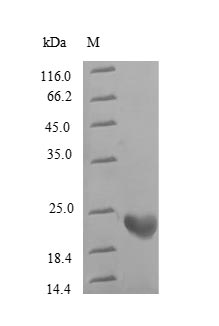This recombinant human rhodopsin (RHO) protein comes from E. coli expression and covers amino acids 1-36 of the full protein. The fragment carries an N-terminal 6xHis-SUMO tag, which makes purification and detection much more straightforward. SDS-PAGE analysis shows the protein achieves greater than 90% purity—a level that should deliver reliable results for most research work.
Rhodopsin acts as a light-sensitive receptor that plays a central role in visual phototransduction. The protein handles the critical job of converting light into electrical signals within the retina. Because rhodopsin sits at the heart of vision, studying it may help researchers better understand how we see and what goes wrong in various visual disorders. This makes it a particularly valuable target for sensory biology research.
Potential Applications
Note: The applications listed below are based on what we know about this protein's biological functions, published research, and experience from experts in the field. However, we haven't fully tested all of these applications ourselves yet. We'd recommend running some preliminary tests first to make sure they work for your specific research goals.
Human rhodopsin is a complex GPCR that requires precise seven-transmembrane domain folding within a lipid membrane environment, along with the chromophore 11-cis-retinal for functional activity. This recombinant rhodopsin represents only the N-terminal extracellular domain (amino acids 1-36), which is a small, unstructured region in isolation. While E. coli can express this short peptide, it cannot provide the membrane environment or post-translational modifications necessary for the full protein's native conformation. This fragment will not adopt any biologically relevant structure related to rhodopsin's phototransduction function and is essentially a linear peptide with no functional activity.
1. Antibody Development and Validation
This recombinant rhodopsin fragment serves as an excellent immunogen for generating antibodies specific to the N-terminal region of human rhodopsin. The short, linear nature of the peptide makes it ideal for producing antibodies that recognize linear epitopes. The His-SUMO tag facilitates purification and immunization procedures. These antibodies will be particularly useful for Western blot applications under denaturing conditions.
2. ELISA-Based Binding Assays
This protein is well-suited as a standard in ELISA assays designed to detect antibodies against rhodopsin's N-terminal region. However, it is completely unsuitable for functional binding studies (e.g., with transducin or other signaling partners) as it lacks the structural requirements for specific molecular recognition.
3. Biochemical Characterization and Stability Studies
This application is valuable for understanding the physical properties of this specific peptide fragment. Techniques like circular dichroism can confirm its unstructured nature, while stability assays can determine its behavior under various conditions. However, these studies will characterize a peptide fragment, not the functional rhodopsin protein.
Final Recommendation & Action Plan
This recombinant rhodopsin is essentially a short peptide fragment of rhodopsin's N-terminus and should be treated as such, not as a functional protein domain. The immediate priority is Application 3 (Biochemical Characterization) to confirm the peptide's unstructured nature and stability profile. Application 1 (Antibody Development) can proceed confidently for generating sequence-specific antibodies. Application 2 is only suitable for immunoassay development, not functional binding studies. Protein-protein interactions require a precise tertiary structure that this short linear peptide cannot provide. Results would be uninterpretable. For any functional rhodopsin studies, a full-length protein expressed in eukaryotic membrane systems is essential.






